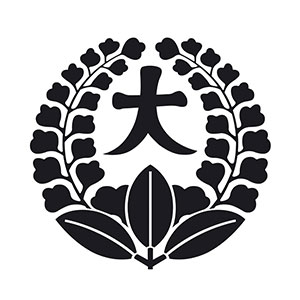Odawara Domain (2/2)Many of the successive feudal lords served as the Shogunate.

Okubo family crest "Nasufuji"
- Article category
- History of the domain
- domain name
- Odawara Domain (1590-1871)
- Affiliation
- Kanagawa Prefecture
- Related castles

Odawara Castle
- related castles
Okubo Tadamasu sold his treasured Masamune's long sword and tried to be frugal, but he was unable to do so, and in the end, the residents of 104 villages in Ashigarakami District and 59 villages in Sunto District were considering filing a direct appeal to the Shogunate. seek relief. As a result, 60,000 koku of the Odawara domain's territory, in the Ashigara and Mikuriya regions, which were particularly affected by the eruption, became Tenryo (territory under the direct control of the shogunate). In return, the Odawara domain was given alternative locations in Izu, Mino, and Harima. Afterwards, Kanto District Governor Ina Tadajun was appointed as general magistrate of reconstruction, and 480,000 ryo, collected through temporary taxation from feudal lords across the country, was used for reconstruction costs to improve land and rivers in the disaster-stricken areas.
It was 35 years later, in 1747, that the 60,000 koku Ashigara/Mikuriya region, which became a Tenryo, was converted into the Odawara domain. The lord of the domain was Okubo Tadamasa's grandchild, Tadaoki. However, even after the territory was converted, volcanic ash accumulated on the riverbed, causing frequent flooding of the Sakawa River, and flood control work was only completed in 1783, 76 years after the eruption. .
The activities of Sontoku Ninomiya and the Odawara domain
The Odawara domain, which was hit by natural disasters, faced serious financial difficulties in the late Edo period. Tadamasa Okubo, the 9th lord of the domain, thought of overcoming this financial difficulty by reforming the domain's administration. He tried to rebuild the domain's finances by making important use of Ninomiya Sontoku, who had succeeded in rebuilding the finances of the Hattori family, a senior vassal of the Odawara domain. Because Sontoku Ninomiya was from a peasant family, many of his vassals opposed his low social status, but Okubo Tadazane overcame the opposition and gave him important status, providing him with 1,000 ryo of gold and a large amount of stored rice, and providing him with a farm village. Supported reform. Thanks to this, Sontoku Ninomiya's rural reforms were almost successful, but Okubo Tadazane suddenly fell ill. When he died of illness at the age of 57 in 1837, the reform was only half way through. However, Sontoku Ninomiya's accomplishments were significant, especially his improvement of the one-to-masu and the unification of standards within the domain, which greatly helped prevent the embezzlement of annual tax.
The end of the Edo period and the Odawara domain
Tadayori Okubo, the 11th lord of the Odawara domain, was a cousin of the last shogun, Yoshinobu Tokugawa. Therefore, during the Boshin War, they surrendered to the government army and surrendered the Hakone checkpoint, but when the government army was at a disadvantage due to attacks by the former shogunate army, they defected to the former shogunate army. Afterwards, he was persuaded to side with the government army again, but was accused of betrayal and in 1868 was forced to live in seclusion and hand over the headship of the family to his adopted son, Tadayoshi. The stone height has also been reduced from 113,000 koku to 75,000 koku.
Okubo Tadayoshi, the last feudal lord, took over as head of the family at just 11 years old. Later, in 1869, when land ownership was restored, he was appointed governor of the Odawara domain, but in 1871, the domain was abolished and prefectures were established, and he was dismissed as governor. Afterwards, Tadayoshi entered Keio University, but in 1875, due to illness, he returned the headship of the family to Tadayoshi Okubo. Tadayoshi served in the Seinan Rebellion that broke out in 1877, and was killed in action at Kumamoto Castle. He passed away at the young age of 21. After the headship of the family was returned to Tadayoshi, Tadayoshi Okubo once again assumed the position of lord, becoming the 13th generation. Tadayori Okubo was later given the rank of viscount by the Peerage Ordinance, and died of illness at the age of 57.
summary
The Odawara domain has had few transfers among Japanese domains, and the Okubo family has been the lord for many years. Because the first generation was a senior vassal of Tokugawa Ieyasu, the family produced many Rojyu (rochu). On the other hand, Odawara was hit by natural disasters such as the large eruption of Mt. Fuji, and the feudal government became increasingly strained towards the end of the Edo period. Some feudal lords, such as the ninth lord Okubo Tadamasa, tried to rebuild their domain by appointing talented people, but they gave up halfway through the process. However, there are still some people whose great achievements are remembered, such as Sontoku Ninomiya.
Descendants of the Okubo family still exist today, and the "Okubo family" also continues to exist.
Reread the article on Odawara Domain
- related castles

- WriterAYAME(Writer)I am a writer who loves history, focusing on the Edo period. My hobbies are visiting historical sites, temples and shrines, and reading historical novels. If there is a place you are interested in, you can fly anywhere. I'm secretly happy that the number of sword exhibitions has increased recently thanks to the success of Touken Ranbu.



